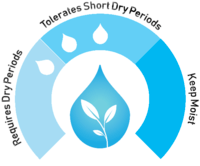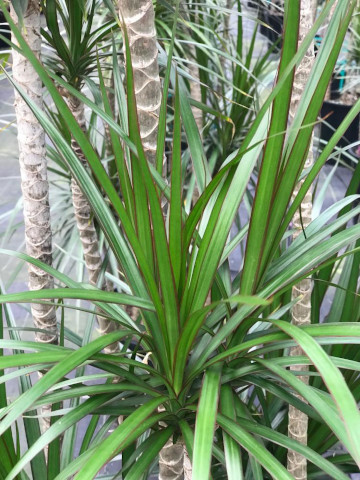
The Marginata is an impressive indoor plant versatile enough for many settings. Long slender leaves bending gracefully down create a soft feathery look. We offer this interiorscape staple as a multi-cane, multi-head 6-7 foot tall plant in a 14 inch pot.
The meters below indicate a range of light and tolerance to drought. The ranges are indicated by the little light bulbs and the small water drops.
Light Instructions

Water Instructions


Mealybugs can be removed with a systemic insecticide drench (see links below) and hand cleaning. Thorough hand cleaning is difficult since mealy bugs can be deep inside the emerging new foliage. Exposed mealybugs can be removed by hand, and will help in the effort to completely rid the plant of these insects. If pesticides are not an option, try horticultural oil directly sprayed onto the insects and the places they live. A second and third treatment, if using oils, will be necessary. Space out the sprays at 1 week intervals to break up the mealybug life cycle. Mealybugs like to hide in the newly emerging foliage and at the base of the heads where the head is attached to the cane.
Many Dracaena species will suffer from iron deficiency if either available iron is too low, or the soil is kept too wet. Iron deficiency can be diagnosed when the newer foliage exhibits interveinal chlorosis, (the veins in the leaf are dark green and the leaf tissue in between the veins are lighter in color). Waterlogged soils prevent the uptake of iron and result in an iron deficiency. Waterlogged soil can also cause the death of the smaller feeder roots which will also cause interveinal chlorosis. If root death is the problem, all of the leaves will have a dull unhealthy appearance. Iron alone will not fix this situation. The soil should be allowed to dry and the focus should be on growing new roots. This is a very slow process and adequate fertilizer is needed to recuperate the plant. When too dry, an overall wilted appearance will result, and the leaves will lose their shine. It is better to error on the dry side with Dracaena than on the waterlogged side.
Other Links:
Zamioculcas zamifolia 'ZZ'
Dracaena marginata
